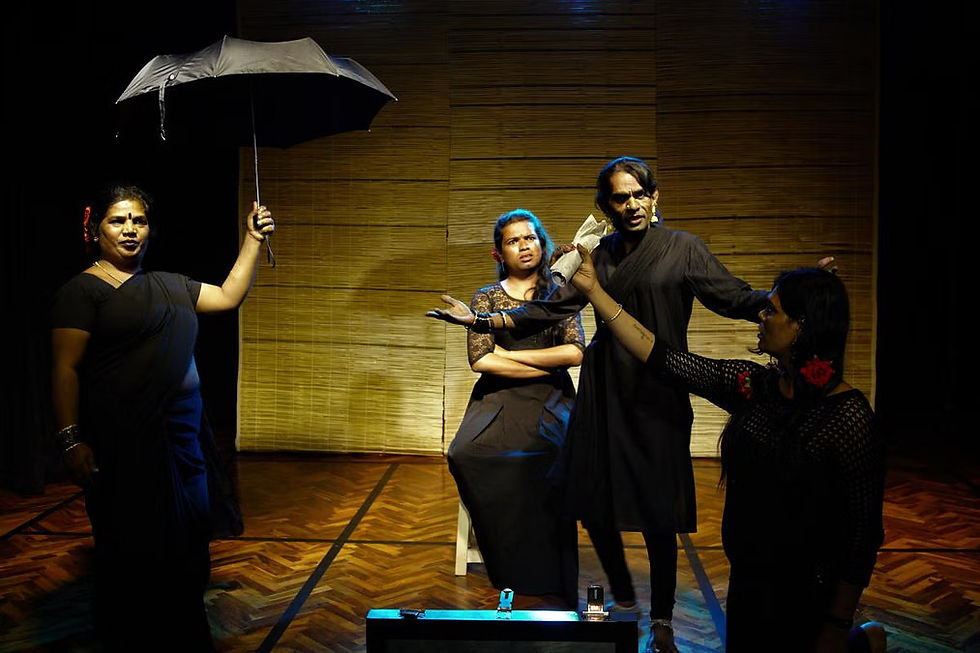Spaced Out
- Laya Kumar
- Feb 12
- 4 min read
Updated: Feb 17
There is a sight from one of my first rides on the Bombay local I’ll never forget - a woman fast asleep, sprawled across three seats at 6.30 in the morning. If you are a regular commuter on the local, you probably understand my initial (read righteous) indignation at this. But I slowly noticed the anger melt into awe, perhaps even a little pride, as I watched women board the train, station after station, leaving the woman to her sleep. There seemed to be a silent agreement - we will not intrude, we will let her sleep because deep down, if and when given a chance, we’d probably do the same.
I’ve thought of this image a lot over the course of the last few months - when India erupted into protests over the recent rape and murder of a doctor at RG Kar Hospital in Kolkata, as the Taliban passed a new law forbidding women from ‘singing, reciting or reading aloud in public’, as an upper class, upper caste women from Hiranandini gardens in Powai forbid a Bahujan women, from Jai Bhim Nagar, from joining their ‘Reclaim the Night’ protest, for we live in a country where your caste and class determine your access to space.
What does it even mean to take up space at a time like this? What sense does one make of this word - reclaim? Is public space truly public? These are some questions that I have been sitting with and when I have questions, I usually turn to the theatre. But I’d like to clarify what I mean by the theatre for the scope of this article. The most famous definition (which I admit I thought I’d begin the article with) comes, of course, from Peter Brook - that all that is required for a piece of theatre to happen is for someone to walk across an ‘empty space’ and for someone to witness this. The most ardent opposition to this notion of theatre has come from Chinese theatre maker and art critic, Zhao Chan. In a lecture to students at the Shanghai theatre institute, he says:
There is no empty space on earth, not with our ever-growing human desires
and overlaying histories. So—this is very important—when we talk about theatre
and drama, we should talk about our relationship with the space when we walk
in and about what this space means.

I am partial to Chan’s definition - to look at a walk as something both theatrical and political. I also prefer this definition as it extends the notion of ‘theatre’ to something more everyday, something more accessible. Mallika Taneja’s Women Walk at Midnight (WWAM) for instance. This initiative began in Delhi in 2016, that drew inspiration from May Krishna Rao’s piece Walk, a response to the 2012 Delhi gang rape. In a recent article, Taneja notes, while there has been a change in Delhi in the last eight years since she started this, the city is still far from safe.
When we walk together, we realise that unfortunately, we are not alone. We knew that always, but to walk together gives us something else – solidarity. A community. A way to strengthen the resistance inside us is by confronting our fears and occupying space.
She talks about how one has to navigate parts of the city that they don’t have access to. That to some women, the night is the only time the city offers them respite. And that to some women, ‘occupying’ space isn’t a midnight walk but rather, rest. Leisure.
One cannot speak about women and the public space in India without talking about Shilpa Phadke’s seminal book, which gave rise to the unconventional Why Loiter campaign, encouraging women to take up space in public for fun and leisure. It takes me back to the image of the woman sleeping on the local train - I’ve encountered countless men sleeping on trains, buses, footpaths - but none of these images have stayed with me. But the woman has. And everyone’s response to her has - perhaps because it felt rare.
A woman sleeps on a train. Another watches.
It’s strange how the act of bearing witness can turn anything theatrical.

This reminds me of Jyoti Dogra’s work. I have watched two of her pieces and something that struck me is how Dogra takes her time on stage. For instance, Maas, her piece on the everyday violence the bodies of women are subject to, opens with Dogra staring at the audience for a good ten minutes or so. There are no lines - just dramatic lights on a body on stage that you begin to pay close attention to everything her body is doing for it says so much more than words ever could. In this act of witnessing Dogra, watching her watching us, one becomes deeply aware of how much our physical bodies dictate how we move through this world.

The last example I want to draw on is Sharanya Ramprakash’s Nava. The piece brings the streets to the proscenium as it features nine trans women taking the audience through the nine rasas as experienced by them in their everyday life.
I’ve taken examples from plays and campaigns that to me are inherently theatre. The word theatre draws from the ancient Greek work theasthai - to behold. Perhaps, if we look at the everyday - walking, loitering, singing, reading, reciting - as theatrical, we will be called to bear witness, and when we witness, perhaps we will all be called to action.
Maybe then, when we don’t have to think of the mundane as radical, we will be closer to reclaiming.
An avid reader and an occasional writer, Laya Kumar, is originally from Coimbatore, recently having graduated from the Drama School of Mumbai.


